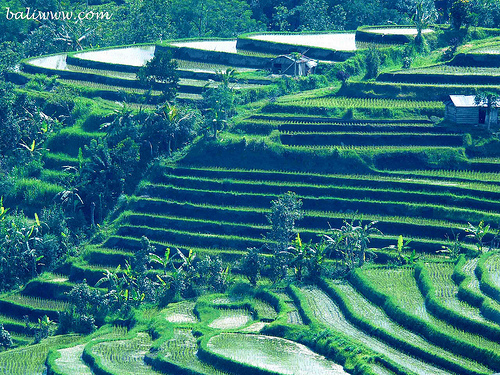Pengrupukan is one day before Nyepi in Bali celebrated by the Hindus of Bali. Nyepi is a day of Saka new year celebration.
Pengrupukan is a day to perform ceremony in order to calm Bhuta (evil spirit) so as not to interfere mankind. The ceremony held on this day in all areas in Bali, called Pecaruan. While the late afternoon or early evening … young people around the region by bringing Ogoh-ogoh accompanied by gamelan tradisional music that was created about a month before.
Besides gamelan, usually accompanied by Tek-tekan (tradisional music with bamboo) had brought by the children.
Then tomorrow, Nyepi is celebrated by doing nothing, people stayed in the house implement Catur Brata Penyepian, that are amati geni (not light a fire), amati karya (not working), amati lelungan (not traveling), and amati lelanguan (no fun). The streets will look lonely without a vehicle, and no activity of the people who look. Around of Bali will no activity even the airport and television channel.
Ogoh-ogoh are statues built for the Ngrupuk parade, which takes place on the eve of Nyepi day in Bali, Indonesia. Ogoh-ogoh normally have form of mythological beings, mostly demons. As with many creative endeavours based on Balinese Hinduism, the creation of Ogoh-ogoh represents spiritual aims inspired by Hindu philosophy.
The main purpose of the making of Ogoh-ogoh is the purification of the natural environment of any spiritual pollutants emitted from the activities of living beings (especially humans). The forms of Ogoh-ogoh represent the Bhuta-Kala (Bhuta: eternal energy, Kala: eternal time), according to Hindu teachings. The imperceptible potentials of nature cannot be thoroughly explored by anyone. Philosophically, civilized men are required to manage the natural resources without any attempts to damage the environment itself.
Aside from being the symbol of Bhuta-Kala, Ogoh-ogoh is considered a symbol of modes of nature that form the malicious characters of living beings. Ogoh-ogoh is usually made by the group of artists found in villages around Bali. After being paraded on a convoy around the town, finally it is burnt to ashes in a cemetery as a symbol of self-purification.
An Ogoh-ogoh is normally standing on a pad built of timber planks and bamboos. This pad is purposed to sustain the Ogoh-ogoh itself during its being lifted and carried around the village or the town’s square. There are normally eight or more men carrying the Ogoh-ogoh on their shoulders. This procession is accompanied by music orchestra performed by the youth. The use of flares is also a main part of the parade.
During the procession, the Ogoh-ogoh is rotated counter clockwise three times. This act is done on every t-junction and roadcross of the village. Rotating the effigies during cremational parade and the eve of Nyepi represents the contact of the bodies with the spirits. It is aimed to bewilder the evil spirits so that they go away and cease harming human beings.
Pengrupukan is a day to perform ceremony in order to calm Bhuta (evil spirit) so as not to interfere mankind. The ceremony held on this day in all areas in Bali, called Pecaruan. While the late afternoon or early evening … young people around the region by bringing Ogoh-ogoh accompanied by gamelan tradisional music that was created about a month before.
Besides gamelan, usually accompanied by Tek-tekan (tradisional music with bamboo) had brought by the children.
Then tomorrow, Nyepi is celebrated by doing nothing, people stayed in the house implement Catur Brata Penyepian, that are amati geni (not light a fire), amati karya (not working), amati lelungan (not traveling), and amati lelanguan (no fun). The streets will look lonely without a vehicle, and no activity of the people who look. Around of Bali will no activity even the airport and television channel.
Ogoh-ogoh are statues built for the Ngrupuk parade, which takes place on the eve of Nyepi day in Bali, Indonesia. Ogoh-ogoh normally have form of mythological beings, mostly demons. As with many creative endeavours based on Balinese Hinduism, the creation of Ogoh-ogoh represents spiritual aims inspired by Hindu philosophy.
The main purpose of the making of Ogoh-ogoh is the purification of the natural environment of any spiritual pollutants emitted from the activities of living beings (especially humans). The forms of Ogoh-ogoh represent the Bhuta-Kala (Bhuta: eternal energy, Kala: eternal time), according to Hindu teachings. The imperceptible potentials of nature cannot be thoroughly explored by anyone. Philosophically, civilized men are required to manage the natural resources without any attempts to damage the environment itself.
Aside from being the symbol of Bhuta-Kala, Ogoh-ogoh is considered a symbol of modes of nature that form the malicious characters of living beings. Ogoh-ogoh is usually made by the group of artists found in villages around Bali. After being paraded on a convoy around the town, finally it is burnt to ashes in a cemetery as a symbol of self-purification.
An Ogoh-ogoh is normally standing on a pad built of timber planks and bamboos. This pad is purposed to sustain the Ogoh-ogoh itself during its being lifted and carried around the village or the town’s square. There are normally eight or more men carrying the Ogoh-ogoh on their shoulders. This procession is accompanied by music orchestra performed by the youth. The use of flares is also a main part of the parade.
During the procession, the Ogoh-ogoh is rotated counter clockwise three times. This act is done on every t-junction and roadcross of the village. Rotating the effigies during cremational parade and the eve of Nyepi represents the contact of the bodies with the spirits. It is aimed to bewilder the evil spirits so that they go away and cease harming human beings.










Tidak ada komentar:
Posting Komentar